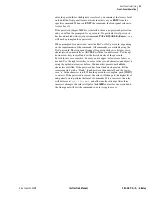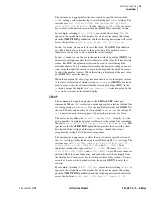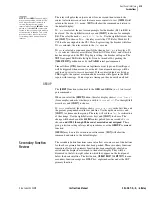
8.15
Date Code 20050919
Instruction Manual
SEL-387-0, -5, -6 Relay
Front-Panel Interface
Pushbuttons
The relay will pulse the output contact for one second then return to the
contact selection screen in case there are more contacts to test.
{CANCEL}
will
return to the main
CNTRL
menu.
{EXIT}
will abort the command and return to
the default display.
If
Close
is selected, the next screen prompts for the breaker (Bk1 to Bk4) to
be closed. Use the right/left arrow keys and
{SELECT}
to choose, for example
Bk1. The relay then asks
Close Bkr 1? Yes No
. Use the right/left arrow keys
and
{SELECT}
to choose. If
Yes
, the relay asserts the CC1 Relay Word bit. If
CC1 has been assigned to the CL1 Close Logic setting, the breaker will close.
If
No
is selected, the relay returns to the
Close
menu.
If
Open
is selected, a sequence exactly like the one for
Close
takes place. If
Yes
is selected, the relay assert Relay Word bit OC1 for Bkr 1, and if this bit
has been assigned to the TR1 Trip Logic setting, the breaker will open. The
TRIP
front-panel LED will also light. It can be turned off by pushing the
{TARGET RESET}
pushbutton or by the
TAR R
serial port command.
Since all three
{CTRL}
functions are legitimate event types, an Event Report
will be triggered whenever any is activated. An automatic message will be
sent to any port set to receive messages. If the contact outputs are listed as
SER triggers, the contact assertion and deassertion will appear in the SER
report, with time tags. Contact operate timing can thus be easily analyzed.
GROUP
The
{GROUP}
function is identical to the
GRO
and
GRO
n
(
n
= 1 to 6) serial
port commands.
When you select the
{GROUP}
button, the relay display shows
Active Group 1
(for example), and asks whether you wish to
Change
or
Exit
. Use the right/left
arrow keys and
{SELECT}
to choose.
If
Change
is selected, the display shows
Change to Group
in the first line, and
the present group number in the second line. Use the up/down arrows and
{SELECT}
to choose another group. The relay will ask for a
Yes/No
verification
of the change. Use the right/left arrow keys and
{SELECT}
to choose. The
change will be made and the
ALARM
contact pulsed for one second if
Yes
is
chosen,
and if SS1 through SS6 are not asserted or not assigned
. These
group selection settings always take precedence over the
GROUP
command
function.
{CANCEL}
may be used to return to an earlier menu.
{EXIT}
will abort the
command and return to the default display.
Secondary Function
Review
The secondary button functions come into effect as soon as one of the buttons
for the above primary functions has been pushed. These secondary functions
remain in effect until a primary function has been completed, aborted, or
exited and the display has returned to the default display. They will be
discussed in the left-to-right order in which they appear on the front panel,
below the horizontal line. The first button,
{TARGET RESET / LAMP TEST}
, has no
secondary function except as a HELP key, explained earlier under the SET
primary function.
NOTE:
The
{CNTRL}
function, while
useful during testing, should not be
used while the relay is actually in
service. During the one-second
interval while contact
OUT10X
is being
pulsed, all other
OUT10Y
contacts are
frozen in their existing state and are
not permitted to change. This could
prevent a trip or other vital output
from being issued during the pulse
interval.
Summary of Contents for SEL-387-0
Page 10: ...This page intentionally left blank ...
Page 16: ...This page intentionally left blank ...
Page 56: ...This page intentionally left blank ...
Page 350: ...This page intentionally left blank ...
Page 388: ...This page intentionally left blank ...
Page 456: ...This page intentionally left blank ...
Page 494: ...This page intentionally left blank ...
Page 528: ...This page intentionally left blank ...
















































